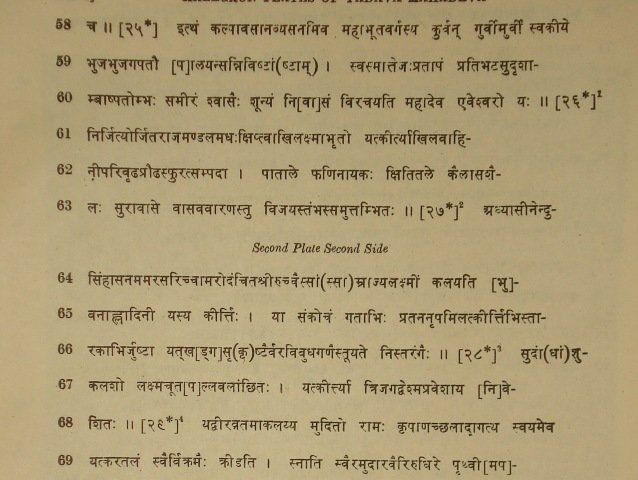|
EPIGRAPHIA INDICA

_______________________________________________
[1] In verses 25-26, Mahādēva, like the great Śiva, is said to have subdued and destroyed the elements. The
luster (tējas) of all the objects known to possess it (especially the lustre of the enemies) fades into insignificance
when Mahādēva with the superior lustre of his white stallions is speeding on the battlefield. When his army is on
the move, huge columns of dust arise and settle on the surface of the ocean. Thus the water element is destroyed
(cf. karṇagamya) by Mahādēva. The element of wind is destroyed (saṁhṛita) inasmuch as Mahādēva withdraws
(cf. saṁhṛita) the life-breath of all enemy king. The members of the royal families of the enemies are required to
take shelter in mountain caves [and forest recesses] when the enemies are no more. This means that the ākāśa element which is nothing but śūnyātā (emptiness) is also destroyed in the caves. All this disaster of the deluge sets
in because Mahādēva subdues the earth. But after that he creates tējas in the form of his valour, water (i.e.
tears) from the eyes of the enemies’ wives, wind from their sighs and ākāśa (void, loneliness) in their houses.
Thus there is Vastu-dhvani (i.e. suggestion of the superb valour of the king). In verse 26, there is Anuprāsa as
also Sāṅgarūpaka in that there is the superimposition of Īśvara and his divine deeds on Mahādēva and his
achievements.
[2] These is Atiśayōkti of the asambandhē sambandhaḥ type at the basis of Tulyayōgitā (cf. Phaṇi-nāyaka, Kailāsa-śaila and Vāsava-vāraṇa with a single kriyā). [There is Mālārūpaka, not Tulyayōgitā.─ Ed.]
[3] Mahādēva’s fame ascended (reached) the throne of the moon, had its glory heightened (udañchita-śrī) by the
chowry in the form of the heavenly Ganges, possessed eminently (uchchaiḥ kalayati) the glory of sovereignty, gladdened the universe, was waited on (jushṭā) by the stars which were only the contracted forms of the reputations of
former kings pooled together, and was eulogised by large groups of gods standing motionless (nistaraṅgaiḥ) [with
admiration] as they were enamoured (kṛishṭa) of [his skill in] swordsmanship. [The correction of sṛishṭa to kṛisṭa
is unnecessary as it refers to the persons who died while fighting with Mahādēva and went to heaven (i.e. became
gods).─ Ed.]
[4] The idea that Mahādēva’s fame had reached upto the moon is expressed by a Samasta-vastu-vishaya-rūpara
in which three upamānas are superimposed on three upamēyas.
|